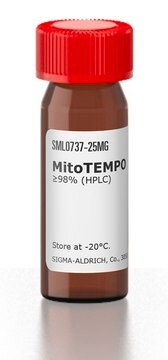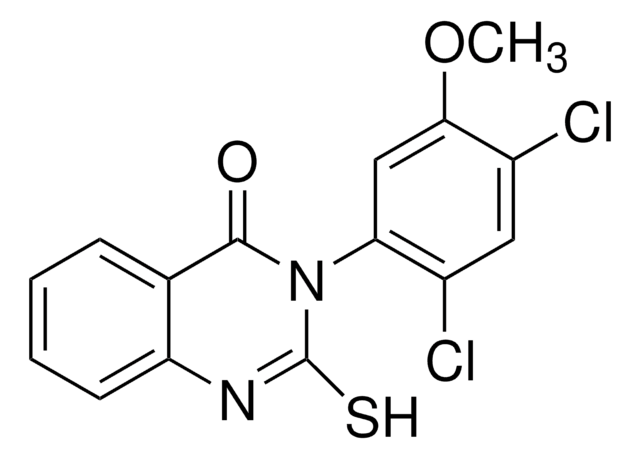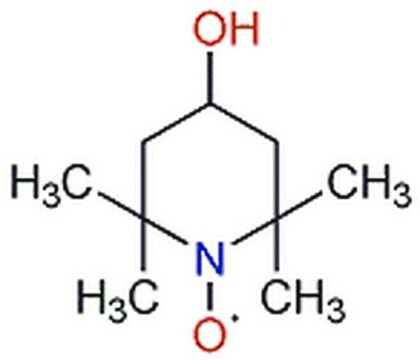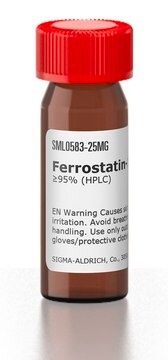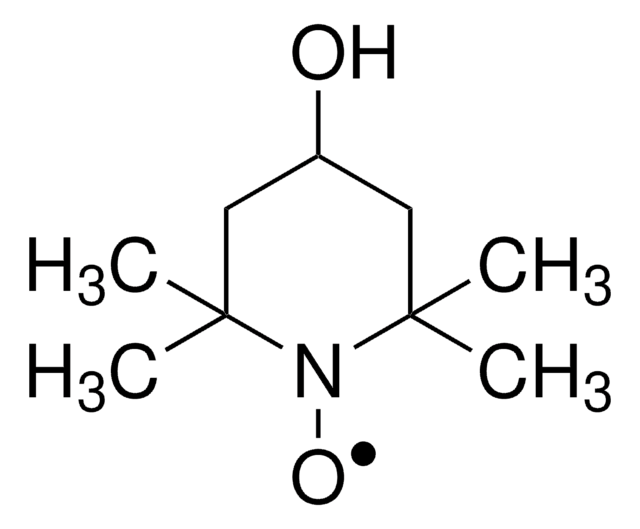SML0629
Mitochondrial Fusion Promoter M1
≥95% (HPLC)
Synonym(s):
(E)-4-Chloro-2-(1-(2-(2,4,6-trichlorophenyl)hydrazono)ethyl)phenol, 1-(5-Chloro-2-hydroxyphenyl)-ethanone 2-(2,4,6-trichlorophenyl)hydrazone
Sign Into View Organizational & Contract Pricing
All Photos(1)
About This Item
Empirical Formula (Hill Notation):
C14H10Cl4N2O
CAS Number:
Molecular Weight:
364.05
UNSPSC Code:
12352200
NACRES:
NA.77
Recommended Products
assay
≥95% (HPLC)
form
powder
color
white to beige
solubility
DMSO: 10 mg/mL, clear
storage temp.
2-8°C
Application
Mitochondrial Fusion Promoter M1 has been used as a fusion promoter:
- to study its effects on peroxisome proliferator-activated receptor-γ coactivator (PGC)-1α expression in breast cancer cells
- to study the link between nucleoside diphosphate kinase 3 (NME3)-regulated mitochondrial fluctuations and stability of genome in NME3 knockdown cells
- to study its effects on mitochondrial fusion in neuronal cells
Biochem/physiol Actions
Mitochondrial Fusion Promoter M1 is a cell permeable hydrazone that enhances mitochondrial fusion. M1 protects cells from mitochondrial fragmentation associated cell death. Mitochondrial Fusion Promoter M1 does not interfere with endoplasmic reticula (ER) and lysosomes morphology.
Storage Class
11 - Combustible Solids
wgk_germany
WGK 3
flash_point_f
Not applicable
flash_point_c
Not applicable
Certificates of Analysis (COA)
Search for Certificates of Analysis (COA) by entering the products Lot/Batch Number. Lot and Batch Numbers can be found on a product’s label following the words ‘Lot’ or ‘Batch’.
Already Own This Product?
Find documentation for the products that you have recently purchased in the Document Library.
Customers Also Viewed
Kehan Ren et al.
Experimental cell research, 400(1), 112493-112493 (2021-01-25)
Most cancer deaths are due to the colonization of tumor cells in distant organs. More evidence indicates that overexpression of RACGAP1 plays a critical role in cancer metastasis. However, the underlying mechanism still remains poorly understood. Here we found that
Minjie Shen et al.
Nature neuroscience, 22(3), 386-400 (2019-02-12)
Fragile X syndrome results from a loss of the RNA-binding protein fragile X mental retardation protein (FMRP). How FMRP regulates neuronal development and function remains unclear. Here we show that FMRP-deficient immature neurons exhibit impaired dendritic maturation, altered expression of
Chih-Wei Chen et al.
International journal of molecular sciences, 21(14) (2020-07-28)
NME3 is a member of the nucleoside diphosphate kinase (NDPK) family that binds to the mitochondrial outer membrane to stimulate mitochondrial fusion. In this study, we showed that NME3 knockdown delayed DNA repair without reducing the cellular levels of nucleotide
Ryohei Iwata et al.
Science (New York, N.Y.), 369(6505), 858-862 (2020-08-15)
The conversion of neural stem cells into neurons is associated with the remodeling of organelles, but whether and how this is causally linked to fate change is poorly understood. We examined and manipulated mitochondrial dynamics during mouse and human cortical
Our team of scientists has experience in all areas of research including Life Science, Material Science, Chemical Synthesis, Chromatography, Analytical and many others.
Contact Technical Service